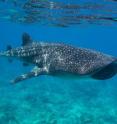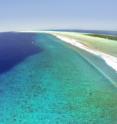The Maldives and the whale shark: The world's biggest fish adds value to paradise
They are the largest fish in the world but the impact of this majestic and charismatic animal on the economy of the island nation of the Maldives was largely unknown. A new study by scientists of the Maldives Whale Shark Research Programme (MWSRP) reveals that a small group of whale sharks in a single Maldivian Atoll accounts for nearly 3% of the global shark ecotourism and nearly half that of the Maldives'. "The Republic of Maldives hosts one of few known year round aggregation sites for whale sharks," said James Hancock co-author and a director of MWSRP. "We have seen that they have become a major tourism draw to South Ari atoll, but we didn't expect these big numbers." The South Ari atoll Marine Protected Area (S.A.MPA) alone attracted 77,000 tourists in 2013. This equates to $9.4million USD in direct income to operators who offer the chance to glimpse this famous 'bucket list' animal.
This is the first value that has been attributed to what is a burgeoning industry in the Maldives. It is also the first time that a valuation for a wildlife viewing experience has been calculated exclusively from observational studies. "Instead of surveying tourists and extrapolating results we actually went out and counted how many boats and people were in the water looking for sharks" said Neal Collins, a joint researcher from IUCN and MWSRP and one of the authors of the study. "By doing so we were able to estimate not only how many people were interacting with the sharks, but also where and how they do it" added co-author Fernando Cagua.
"When we include the whale sharks from South Ari Atoll, we were able to adjust previous estimates of annual 'shark related' tourism expenditure in the Maldives from $12 million USD to nearly $20 million" said Fernando. "There are still many mysteries about these whale sharks -- we don't know why they come here or for how long they stay -- but bringing the money issue to the table is an important step towards ensuring their conservation."
Despite the South Ari Atoll Marine Protected Area (S.A.MPA) being the most popular whale shark viewing region in the Maldives, this area is as yet unregulated. This study, published today in the peer-reviewed journal PeerJ, highlights how the implementation of a management plan which safeguards this aggregation site would reduce the possible economic impact that would result from the sharks leaving the area due to stresses from the attention they receive.
The S.A.MPA was first designated in 2009. At 42 square kilometers it is the largest protected area in the Maldives. An accepted management plan was not reached at the original time of designation. Therefore, this study has proven timely, as consultations with local communities and tourism industry representatives have again begun, with a more determined effort to create a world class whale shark tourism destination.
"In a sense the whale sharks here are perfect for wildlife tourism. They are the largest shark in the world and the slow moving, shallow swimming behaviour they exhibit in S.A.MPA waters makes them accessible not just to scuba divers but also to snorkel excursions. This opens up an incredible wildlife experience to just about everyone, which of course brings with it a degree of risk in terms of the welfare of both the sharks and the tourists" said Richard Rees, director of MWSRP. "The encouraging thing is that everyone in the industry we talk to agrees these risks need to be managed and the local communities are receptive to participating in the management of the area." he added.
Source: PeerJ
Other sources
- The Maldives and the whale shark: World's biggest fish adds value to paradisefrom Science DailyWed, 13 Aug 2014, 10:02:08 UTC
- The Maldives and the whale shark: The world’s biggest fish adds value to paradisefrom Science BlogTue, 12 Aug 2014, 13:00:45 UTC
- The Maldives and the whale shark: The world's biggest fish adds value to paradisefrom PhysorgTue, 12 Aug 2014, 12:00:57 UTC


